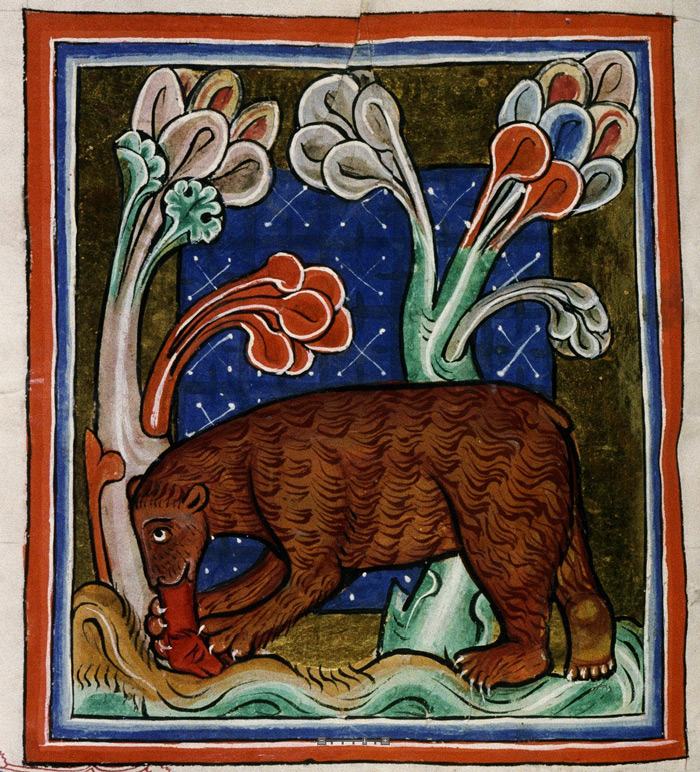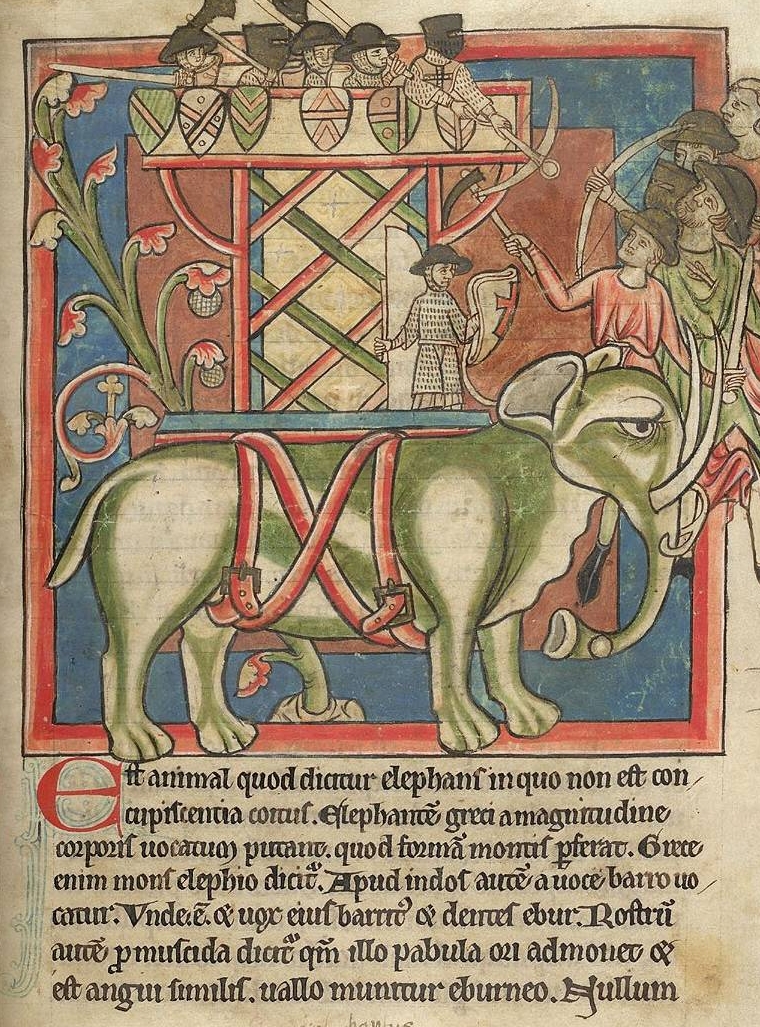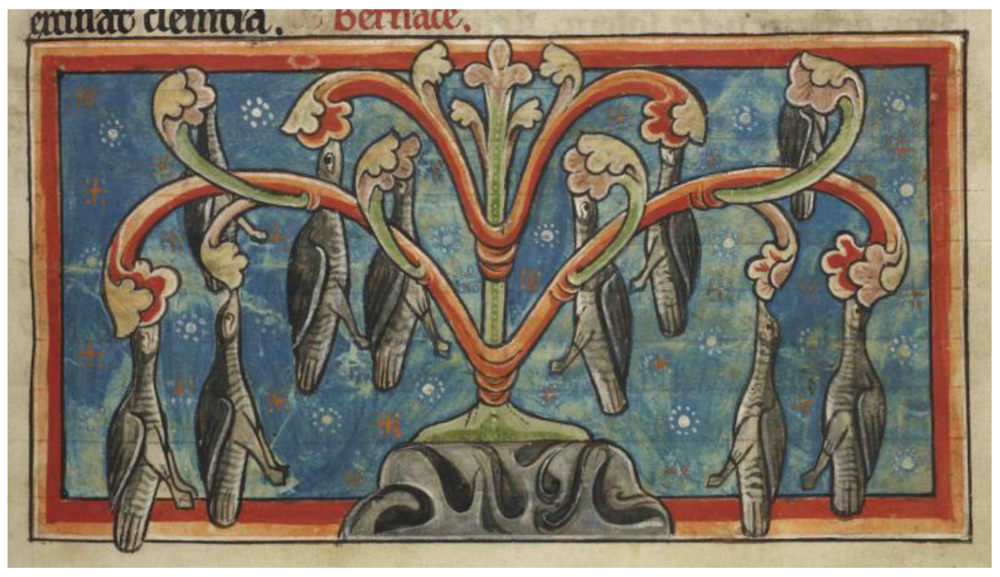“I can’t make this up” has long been a mantra of mine and I hold research to be a very important part of the creative process. So in writing fantastical creatures for my own novel’s fairyland, I read far and wide, including a medieval bestiary.
Medieval bestiaries are excellent sources of the strange. They have between their pages the early myth of sirens (part bird, part human, part fish), dragons and other fantastical mishmash composite beasts.
But my favourite part of medieval bestiaries are the seemingly “normal” animals. They were as much written to describe the natural world as to make sense of it. It is often said that God wrote two books, one was the bible, but the other was creation itself. The study of one, therefore mirrored the study of the other. Bestiaries set out to find the allegories left by God in nature and are as keen to impose that framework onto their observations as they are in actually testing what they have been told.
Thus I have long found humour in the weird assertions that medieval writers have made about animals, such as elephants not having knees or ants hoarding gold. And these “facts” are still funny, but here I want highlight a few places where their stories intersected with reality.
The Gold-Digging Ants
The story of the giant gold-digging ants date back to Herodotus, the father of lies and history. The story goes that these giant dog-sized, furry ants dig grains of gold from the ground. They guard this gold with military precision and diligent action.
It’s a ridiculous tall tale story, but where did it come from?
And is an ant really an ant when it is quite that big and furry?
Herodotus was also very keen on there being winged serpents in Egypt. I’ve long thought of him as travel writer keen to tell you all the stories random people tell him at the pub.
And with the ants, it is possible that it’s just a misunderstanding born out of a translation error. The Persian word for marmot and mountain ant are similar, and there is indeed a species of fox-sized marmot who regularly uncover gold dust in a province of Pakistan due to how rich that ground is in gold.
The Bear

The story of bears giving birth to shapeless lumps of meat which the mother bear then has to then aggressively lick into shape (where that phrase comes from) is a fantastic one. Many bestiaries try to show just this scene, with a bear-faced cube at the end of the bear’s tongue.
Bears obviously do actually give birth to tiny bears, but a quick image search will throw up pictures of hairless newborn bears that both distinctly uncute and can be conceivably mistaken for shapeless lumps. The most infamous of the ugly newborn bears phenomenon is, of course, the panda, but they really are no exception. It takes a little while for them to open their eyes and develop the adorable fur.
It’s also worth noting that bears do lick their cubs quite a lot. They do so to clean them and also out of affection. If there is a drip in their cave, they’ll even lick the water from the wee one’s face.
The Elephant
The Elephant is depicted in MS Bodley 764 with a tower strapped to its back and is bristling with armed soldiers. Given the way its tusks and ears are drawn, it is obvious that the illuminator is more familiar with cows than elephants, but despite the fact that the manuscript doesn’t believe elephants have knees, it also contains an intriguingly plausible story.
“[Elephants] live for three hundred years. If, however, they want to have offspring, they go to the east, near the earthly paradise, where a tree called mandragora grows. The elephant and his mate go there, and she picks a fruit from the tree and gives it to him. And she seduces him into eating it; after they have both eaten it, they mate and the female at once conceives. When the time comes for her to give birth, she goes to a pond, and the water comes up to her udder. The male elephant guards her while she gives birth, because the dragon is the enemy of the elephant. If the elephant finds a snake he will kill it by trampling on it until it is dead.”
As the writer later points out more obviously, this tale draws a clear parallel between elephant reproduction and original sin. Adam is the male elephant and Eve is the female, seducing him to fall.
But there may be more to the whole mandragora business than just allegory as elephants have been observed to self-medicate in order to induce labour. A heavily pregnant elephant walked for miles to find a tree that elephants don’t normally eat from and devoured it completely. Four days later, a calf was delivered.
Furthermore, elephants are also known to practice water births.
Hyena
Hyenas are always described as unclean and depicted hauling corpses out of graves to eat. They can paralyse an animal by looking at it three times and have a stone in its eye that allows people to tell the future if placed under their tongue. But the other interesting about them is that they’re also described as sometimes masculine and sometimes feminine.
This one is quite simple and probably not very obscure. They probably thought hyenas could change their sex because female spotted hyenas have a “pseudopenis” that is used not just for display but also urination, copulation and childbirth. Hyenas are a fascinating gender-bending species with a matriarchal society. Hyenas are just kinda badass.
Barnacle Geese
The barnacle are always adorable in their depiction, given how they hang limply from a tree by their beaks. They are drawn that way because they hatched the usual way, but instead are produced by nature “in a way which contradicts her own laws”. Medieval bestiaries describe barnacle geese as growing from pine logs floating on water, their bodies protected by a hard shell that they may grow more freely, taking their food from the sap of the wood and the sea in a mysterious fashion. Unusual among medieval writers, MS Bodley 764’s writer even states that they have seen such barnacles with their own eyes, thousands of their birdlike bodies clinging to a log by their beaks.
There is speculation that this bit of folklore originates more from the monk’s desire to eat the bird during fast days (since they can’t eat anything of flesh or born of flesh), though Pope Innocent III explicitly prohibited their consumption during Lent, arguing that their strange reproductive cycle did not excuse the fact that they did act and behave an awful lot like other birds. This debate continues throughout the middle ages, with other writers wading in, including the Holy Roman Emperor Frederick II noting the lack of avian embryos within the barnacle when dissected.
The barnacle geese’s annual migratory disappearance did perplex the medieval mind. They were, of course, just migrating to the Arctic in order to breed during the summer. The goose barnacle with colouring and markings similar to the barnacle geese, especially with a tapered tail, were thus linked to the geese and believed to be their origin.
Under the Pendulum Sun

Catherine Helstone’s brother, Laon, has disappeared in Arcadia, legendary land of the magical fae. Desperate for news of him, she makes the perilous journey, but once there, she finds herself alone and isolated in the sinister house of Gethsemane. At last there comes news: her beloved brother is riding to be reunited with her soon – but the Queen of the Fae and her insane court are hard on his heels.
Jeannette Ng is originally from Hong Kong but now lives in Durham, UK. Her MA in Medieval and Renaissance Studies fed into an interest in medieval and missionary theology, which in turn spawned her love for writing gothic fantasy with a theological twist. She runs live roleplay games and is active within the costuming community, running a popular blog. Jeannette has been a finalist for the John W. Campbell Award for Best New Writer, and recently won the Sydney J Bounds Award (Best Newcomer) in the British Fantasy Awards 2018.



I’ve always liked the vegetable lamb the best, just for its illustration of how people from different contexts form categories differently. Lev Vygotsky, the Russian psychologist, observed that among city folk and peasants, when asked what a rabbit and a dog had in common, the city dwellers would tend to say things like “four legs” or “fur” but the peasant would tend to say “I can use a dog to catch a rabbit”.
Well this is a fascinating subject! Also everyone should read Under the Pendulum Sun because it’s so very weird and a fantastic read. 🙂